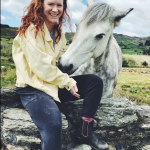Support
During the Spring semester of 2019, I lived and learned in Derry/Londonderry, Northern Ireland as an ISEP student at Ulster University’s Magee campus. I was incredibly fortunate to receive the Hallenbeck Endowment for International Studies which supported my desire to expand upon my fascination for the complexity of the Irish Identity. Throughout my semester I was able to explore the cultural significance and representations of Irishness in Northern Ireland and Ireland in the cities of Derry, Belfast, Dublin, and Cork.
Studying in the historic city of Derry I was very aware of the division of Irish identity. Derry is a city of opposing names, with a belief in opposing religions, with people of opposing national identities, who recognize opposing languages, and are allegiant to opposing political parties. Using a portion of the Hallenbeck’s generous grant I was able to dig deeper into the history behind the current dichotomy in Derry’s society in order to better understand how this small city reflected upon the greater meaning of Irishness. I walked Derry’s ancient walls, shed a tear at the Bloody Sunday memorial, and absorbed Derry’s rich and tumultuous history in the Museum of Free Derry and the Siege Museum. Derry’s proximity to the border that separates the Republic of Ireland and Northern Ireland makes it a critical location of history between the two countries. But there is more to Irishness than just Derry.
Visiting Belfast was certainly a change of pace from Derry. With more modern architecture and cultural diversity, this city is just as historic as Derry and yet it feels more connected to the nation’s present and future. Belfast, however, is still a city divided with neighborhoods and schools largely segregated between Catholics and Protestants. Here, I was able to experience the historic and modern representations of these divided identities by visiting the Belfast Peace Walls, the Ulster Museum, and Belfast City Hall. As the capital city of Northern Ireland, Belfast was a critical place for me to visit in my pursuit of understanding the complexity of Irish Identity.
In the grand city of Dublin, I was able to see an entirely different display of Irishness. I was lucky to be able to visit the city on none other than St. Patrick’s Day. While this experience may not have been completely authentic, as many tourists are drawn to the city on this day from all over the world, I was still intrigued by the differences I was able to notice between the cities in Northern Ireland and Dublin. The people of the Republic of Ireland are proud of their national identity and hold it dear as a symbol of freedom won against the British. This form of Irishness largely contradicts the Irish identity of many living in Northern Ireland who are nationally British but claim Irishness. After my visit to Dublin, though, I still had one more dimension of this complex identity to explore.
When my coursework finished in May, I traveled to West Cork in the Republic of Ireland to join my grandparents and learn about my own Irishness. In Skibbereen, they introduced me to cousins whom I’d never before met and who shared strikingly similar features to my own. Here, Northern Ireland was not referred to as a nation separate from the Republic, but rather, “the North of Ireland.” Here, I found people to be less concerned with each other’s religions and seemingly more removed from the long-standing division of Protestants and Catholics on the island. Beyond the societal difference of Irishness in Cork, I was also able to explore my own relation to Irishness. Visiting the very home in which my great grandfather was born and raised, I felt connected to my roots in a way I have never before experienced, and for which I am so grateful.
I will forever cherish the many experiences I was afforded thanks to the Hallenbeck’s grant. I also hope to analyze these experiences further by incorporating them into an Experiential component project for my Sociology major.
